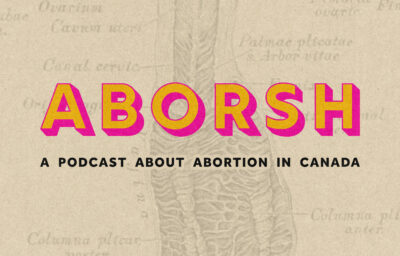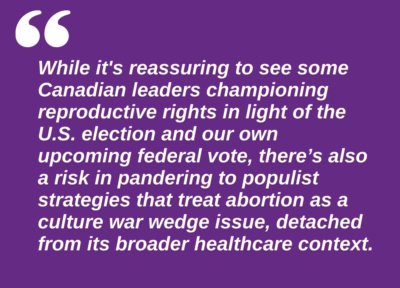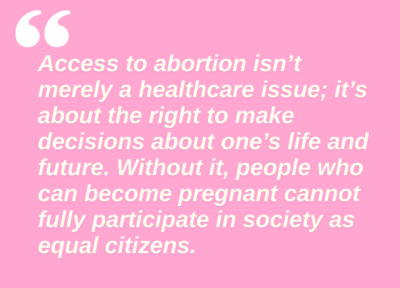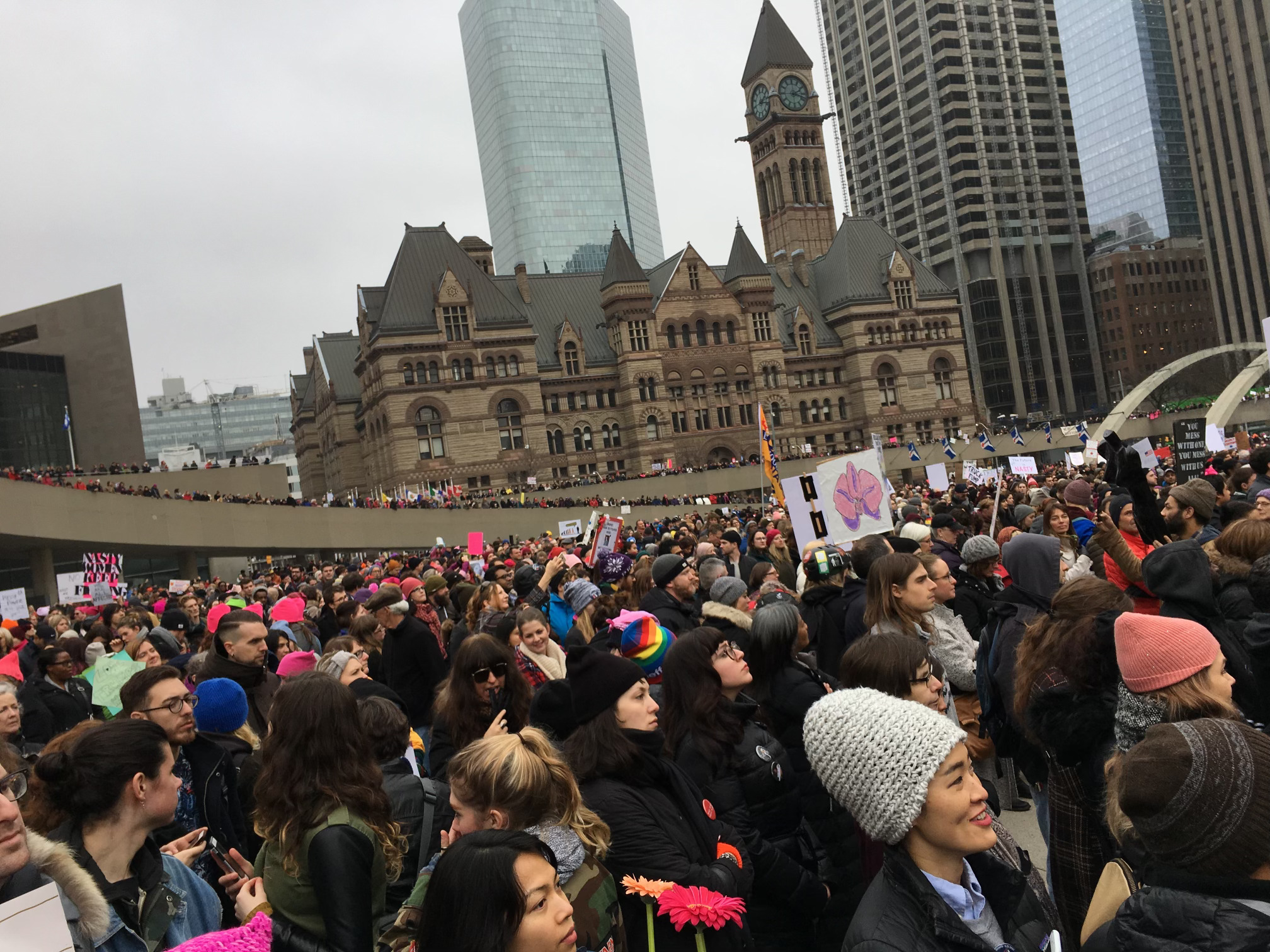“For me, and for so many others, abortion was the start of something,” writes journalist Jessica Valenti in her daily newsletter, where she reports on abortion rights in the U.S. For Valenti, choosing not to become a parent before she was ready gave birth to her career, marriage, and, when the time was right, motherhood.
For me, it was the start of an insatiable geekiness about all things reproductive rights and justice and, eventually, a podcast. As I entered my abortion research era at the end of 2019, I quickly realized that advocates had been sounding alarms for years. Roe’s reversal wasn’t a question of if but when.
Since then, Canadians have watched in horror as millions of Americans have lost access to abortion, faced criminalization for miscarriages, and women and pregnant people have died due to denied or delayed care—all consequences of living in legislated bodies.
As someone who makes a podcast and has written a play about abortion in Canada, I’m often asked, “Could it happen here?” Saying “yes” without context feels like fear-mongering while saying “no” comes too easy—like complacency. Believing we’re immune from the kind of setbacks happening in the U.S. is also misleading.
Now, as I prepare to launch the next season of Aborsh in January, just before Trump’s presidential inauguration, Canadians are once again asking, “Can it happen here?”.

Leading up to November 5th, Canadian political leaders recognized that abortion is on people’s minds. The NDP put forward an opposition day motion in the House of Commons to force a vote addressing the rise of anti-choice activity and to improve abortion access. The Liberals announced plans to amend the Income Tax Act, requiring Crisis Pregnancy Centres—anti-choice organizations posing as medical clinics—to disclose if they provide contacts for abortion and birth control services or risk losing their charitable tax status; something pro-choice advocates have long pushed for to counter misinformation from these groups.
Meanwhile, Conservatives have largely remained quiet on abortion leading up to the U.S. election. However, earlier this year, one of the most extreme members of the Conservative caucus, part of a faction pushing for attacks on reproductive rights, tabled a petition (with fewer than 30 signatures) claiming abortion violates the Charter (it does not). And just last month, U.S. anti-abortion zealot Abby Johnson spoke in support of anti-abortion organizations at a gala in Ontario.
Anti-choice mobilization isn’t the only thing permeating the border; troubling patterns of political polarization are increasingly spilling over from the U.S. to Canada. Take the recent B.C. election, which was too close to call for over a week, with one riding ultimately decided by a mere 27 votes.
Conservative leader Pierre Poilievre’s tactics echo those of the American far right, emphasizing politics of outrage, sloganeering, and fueling social divides to solidify his base. This approach turns issues like abortion, LGBTQ+ rights, vaccines, and climate denial into symbolic battlegrounds—used less for meaningful policy debate and more to stoke anger and consolidate support along ideological lines.
While it’s reassuring to see some Canadian leaders championing reproductive rights in light of the U.S. election and our own upcoming federal vote, there’s also a risk in pandering to populist strategies that treat abortion as a culture war wedge issue, detached from its broader healthcare context.
The NDP’s warnings about abortion access in Canada have rubbed me the wrong way. Their criticism isn’t baseless, but after years of conversations with healthcare providers and advocates, I’m also aware of the progress that’s been made. With the possibility of a Poilievre victory—and his consistent voting record against abortion rights—I want to foster allyship wherever we can get it. But the NDP’s message is also giving the ick of political opportunism.

So, I reached out to Martha Paynter, an advocate I fondly refer to as the “Queen of Abortion in Canada,” though a more accurate title is reproductive health educator and provider. Paynter confirmed my concerns, criticizing the NDP’s approach, arguing it misrepresents the expansion of abortion access forged by advocates. She specifically took issue with Jagmeet Singh’s recent social media post stating, “In New Brunswick, the very last abortion clinic was forced to close its door. What good is a right if you can’t access it?”
Paynter was “flabbergasted by this horrifically inaccurate statement,” countering that New Brunswick currently has three procedural abortion clinics and multiple primary care clinics that provide medication abortions.
While the NDP’s motion claims the Liberal government hasn’t expanded access to abortion over the past nine years, Paynter lists the ways access has improved. Multiple provinces have extended the gestational age duration for abortion care. The number of abortion access points has expanded from about 150 clinics, mostly in urban centers, to countless locations nationwide. This increase is due to the widespread availability of medication abortion, which primary care providers can now prescribe and even mail via telemedicine. “At the same time the U.S. has moved backward, we’ve been making progress,” Paynter says.
Paynter calls out the NDP’s approach as “a stunt, and a bad one.” She believes the federal NDP’s messaging should frame abortion as part of the broader spectrum of reproductive care that women and gender-diverse people often struggle to access, including services for menopause, endometriosis, IVF, and gender-affirming care. She also emphasizes the need to strengthen, enforce, and expand the Canada Health Act, which is under federal jurisdiction, unlike provincially managed healthcare.

Isolating abortion solely as a political issue ignores that it’s one of many essential services threatened by healthcare privatization. Canadian healthcare is under immense strain, with conservative premiers deliberately underfunding it, resulting in a breakdown of services that paves the way for privatization. If privatization expands, access to reproductive care, including abortion, will be jeopardized—especially in provinces like Alberta, where Catholic hospitals refuse the procedure. Privitization could also reduce primary care access and further strain remaining public resources.
Canada’s outdated voting system also makes reproductive rights vulnerable. Canada, the UK, and the US are the only OECD countries still using first-past-the-post, while over 80% of OECD countries have adopted proportional representation. This winner-take-all voting system allows a minority to sway policies, as seen in the U.S., where conservative interests dominate the Supreme Court despite popular opposition. Though Canada’s judicial appointments are currently non-partisan, any Prime Minister could change this. Proportional representation could protect against such shifts by promoting political collaboration and reducing the risk of single-party dominance on key issues like reproductive rights.
Access to abortion isn’t merely a healthcare issue; it’s about the right to make decisions about one’s life and future. Without it, people who can become pregnant cannot fully participate in society as equal citizens.
In light of the erosion of rights in the U.S. and recent attacks on trans youth by conservative political leaders in this country, it’s crucial for Canadians to recognize the link between these issues. Protecting our healthcare system, pushing for electoral reform, and defending the democratic freedoms that underpin both are essential to preserving democracy and safeguarding the rights of all Canadians.
I’ve been thinking a lot about how abortion, ending a pregnancy, is a kind of beginning—a pivotal decision to direct one’s course. Trump’s election likely marks the end of legal abortion and even birth control in the U.S. But it’s the start of a new era of resistance and organizing to build community networks.
As Paynter put it, “The focus needs to be on empowering people to know how to take care of themselves so that any restriction just becomes impossible. We have a lot of public education to do.”




 Follow Us On Instagram
Follow Us On Instagram
